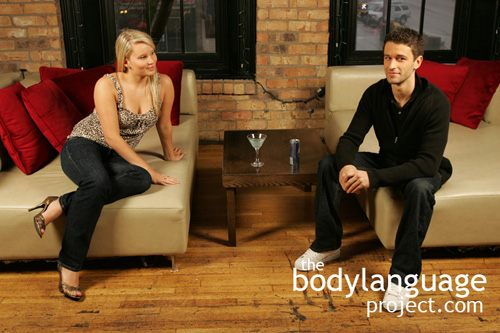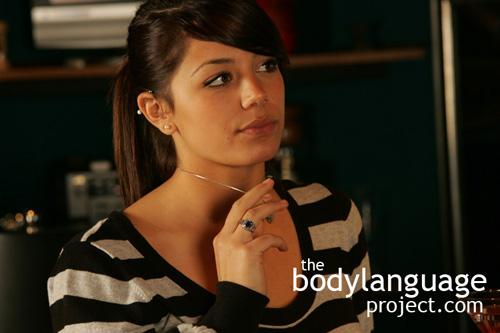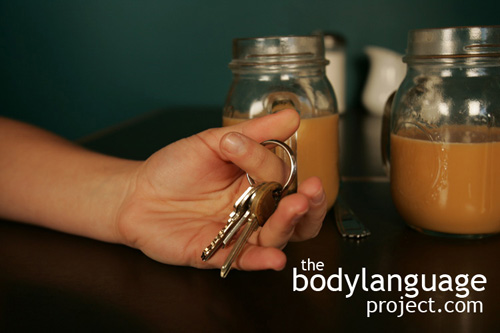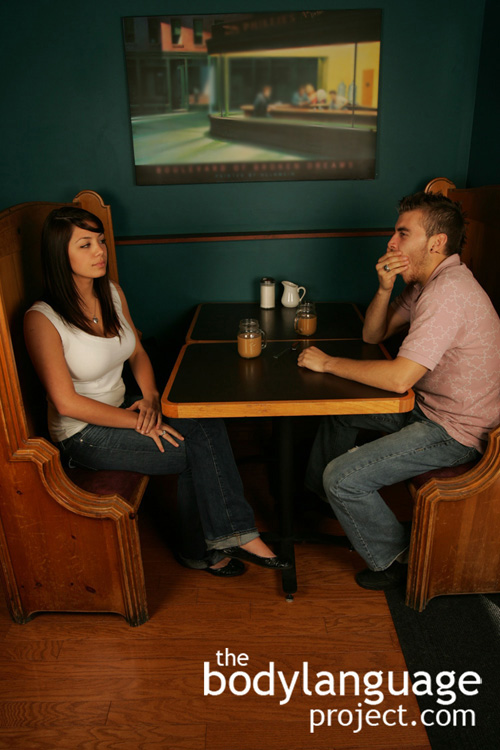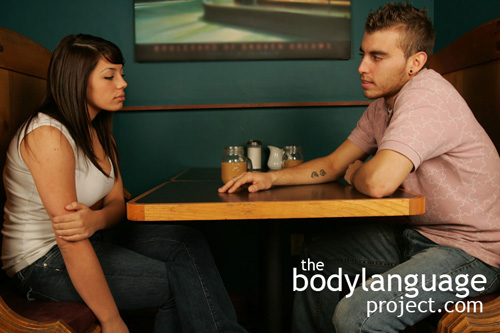Body Language of Polite Smile (the)
Synonym(s): Tight Lipped Smile With Low Intensity.
Description: This smile happens as the lips are stretched across the face using the risorius muscle. Flexing these muscles causes the lips to move toward the ears or curled up modestly. No teeth are showing because the risorius muscles are unable to raise the corner of the lips. The tight-lipped smile can vary with intensity and it is directly related to the amount the lips that are raised in the corners of the mouth.
In One Sentence: The polite smile signals the desire to appease without being overly friendly.
How To Use it: The polite smile is used to acknowledge others without showing a high degree of warmth. When you want to say hello, but don’t want to build a relationship, perhaps due to differences of opinion, then offer the polite smile. Thus, it is useful to maintain peace, while clearly demonstrating a lack of interest in going any more intimate with the relationship. Use this smile with acquaintances, strangers, and people you are forced by their proximity and presence to placate.
Context: General.
Verbal Translation: “I acknowledge you, but don’t know you well enough to give you a full honest smile so I’m just going to stretch my lips toward my ears and offer no upward lip curl.”
Variant: See Smiling, Fear Smile, Friendly Smile, Frown (the) or Downturned Smile, Honest Smile or Duchenne Smile, Jaw Drop Smile, Nervous Smile, Polite Smile (the), Uneven Smile Or Lopsided Smile, Upper Lip Smile, Artificial Smile or Fake Smile, Nervous Smile, Honest Smile or Duchenne Smile, Contempt Facial Expression.
Cue In Action: A man might say about his boss “He’s a great boss, I’d switch companies and follow him anywhere if he left.” and this might be followed by a tight lipped smile serving to negate the comment.
Meaning and/or Motivation: The polite smile indicates a hidden attitude or thought, uncertainty, hesitation or lack of confidence. This smile is used to placate others and frequently shows itself while posing for photographs.
Strangers passing on the street might also use this shallow smile as a form of greeting or acknowledgement. The smile is a feigned or dishonest smile that we employ when we don’t want others to know we aren’t particularly excited to see them. The tight lipped smile is the most commonly used smile when meeting new people. It might also appear out of nervousness or stress.
When the tight lipped smile with low intensity happens in conversation in can serve to negate the previous statement. Small babies have been shown to use this smile for all others except their mothers, whom they reserve the use of the true, honest smile.
Cue Cluster: Expect to see neutral body language that is neither opened nor closed, dominant nor submissive.
Body Language Category: Appease, Automatic gesture.
Resources:
Abel, Ernest L. and Michael L. Kruger. Smile Intensity in Photographs Predicts Longevity. Psychological Science. 2010. 21(4): 542-544.
Seder, J. Patrick and Shigehiro Oishi. Intensity of Smiling in Facebook Photos Predicts Future Life Satisfaction. Social Psychological and Personality Science. 2012. 3(4): 407-413.
http://bodylanguageproject.com/articles/facebook-smile-predicts-life-satisfaction/
Colonnesi, Cristina; Susan M. Bogels; Wieke de Vente and Mirjana Majdandzic. What Coy Smiles Say About Positive Shyness in Early Infancy. Infancy. 2013. 18(2): 202–220. ISSN: 1525-0008 print / 1532-7078 online
DOI: 10.1111/j.1532-7078.2012.00117.x
http://bodylanguageproject.com/articles/nonverbal-meaning-coy-smiles-infants/
Fairbairn, Catharine E.; Michael A. Sayette; Odd O. Aalen and Arnoldo Frigessi. Alcohol and Emotional Contagion: An Examination of the Spreading of Smiles in Male and Female Drinking Groups. Clinical Psychological Science. 2014. DOI: 2167702614548892
http://bodylanguageproject.com/articles/alcohol-social-lubricant-male-smiles/
Gueguen, Nicolas. Weather and Smiling Contagion: A Quasi Experiment With the Smiling Sunshine. Journal of Nonverbal Behavior. 2013. 37:51–55. DOI 10.1007/s10919-012-0140-y
http://bodylanguageproject.com/articles/weather-smile-not-contagion-smile-linked-weather-conditions/
Guéguen, N. The Effect Of A Woman’s Smile On Men’s Courtship Behavior. Social Behavior and Personality. 2008. 36(9): 1233-1236.
http://bodylanguageproject.com/articles/how-women-can-use-a-simple-smile-to-attract-men/
Guéguen, N., & Fischer-Lokou, J. (2004). Hitchhiker’s Smiles And Receipt Of Help. Psychological Reports. 94: 756-760.
Gosselin, Pierre; Reem Maassarani; Alastair Younger and Mélanie Perron. Children’s Deliberate Control of Facial Action Units Involved in Sad and Happy Expressions. Journal of Nonverbal Behaviour. 2011. 35:225–242. DOI 10.1007/s10919-011-0110-9.
http://bodylanguageproject.com/articles/childrens-control-facial-actions-improve-age-create-accurate-emotional-expressions/
Golle, Jessika; Fred W.; Mast and Janek S. Lobmaier. Something to Smile About: The Interrelationship Between Attractiveness and Emotional Expression. Cognition and Emotion, 2014. 28:2: 298-310. DOI: 10.1080/02699931.2013.817383.
http://bodylanguageproject.com/articles/smiles-arent-just-cameras/
Gunnery, Sarah D.; Judith A. Hall and Mollie A. Ruben. The Deliberate Duchenne Smile: Individual Differences in Expressive Control. Journal of Nonverbal Behavior. 2013. 37:29–41. DOI 10.1007/s10919-012-0139-4
http://bodylanguageproject.com/articles/can-probably-fake-honest-smile-deliberate-duchenne-smile/
Hertenstein, Matthew J.; Carrie A. Hansel; Alissa M. Butts and Sarah N. Hile. Smile Intensity In Photographs Predicts Divorce Later In Life. Motiv Emot. 2009; 33:99-105
DOI 10.1007/s11031-009-9124-6
http://bodylanguageproject.com/articles/small-smiles-predicts-divorce/
Harker, L., & Keltner, D. (2001). Expressions Of Positive Emotion In Women’s College Yearbook Pictures And Their Relationship To Personality And Life Outcomes Across Adulthood. Journal of Personality and Social Psychology, 80(1), 112–124. doi: 10.1037/0022-3514.80.1.112.
Krumhuber, E., Manstead, A., & Kappas, A. Temporal Aspects of Facial Displays in Person and Expression Perception: The Effects of Smile Dynamics, Head-tilt, and Gender. Journal of Nonverbal Behavior. 2007. 31(1), 39-56.
http://bodylanguageproject.com/articles/slow-onset-smile-best/
Krumhuber, Eva; Antony S. R.; Manstead; and Arvid Kappas. Temporal Aspects of Facial Displays in Person and Expression Perception: The Effects of Smile Dynamics, Head-tilt, and Gender. Journal Nonverbal Behavior. 2007; 31: 39-56.
DOI 10.1007/s10919-006-0019-x
http://bodylanguageproject.com/articles/head-tilt-and-slow-onset-smile-nonverbals-trust-attraction-dominance-and-flirting-a-brief-report/
Krause, Michael W. and Teh-Way David Chen. A Winning Smile? Smile Intensity, Physical Dominance, and Fighter Performance. Emotion. 2013. 13 (2): 270–279. DOI: 10.1037/a0030745
http://bodylanguageproject.com/articles/smile-lose-smile-intensity-predicts-fighting-ability
Krumhuber, Eva G.; Manstead and Antony S. R. Can Duchenne smiles be feigned? New evidence on felt and false smiles. Emotion. 2009. 9 (6): 807-820.
http://bodylanguageproject.com/articles/can-fake-real-smile-practice/
Labroo, Aparna A.; Anirban Mukhopadhyay; Ping Dong. Not Always the Best Medicine: Why Frequent Smiling Can Reduce Wellbeing. Journal of Experimental Social Psychology. 2014. 53:156-162.
http://bodylanguageproject.com/articles/why-too-much-smiling-can-be-bad-for-you/
Lockard, J. S., McVittie, R. I., & Isaac, L. M. (1977). Functional Significance Of The Affiliative Smile. Bulletin of the Psychonomic Society, 9, 367-370.
Okubo, Matia; Akihiro, Kobayashi and Kenta Ishikawa. A Fake Smile Thwarts Cheater Detection. Journal of Nonverbal Behaviour. 2012. 36:217–225. DOI 10.1007/s10919-012-0134-9
http://bodylanguageproject.com/articles/fake-till-make-cheaters-fake-smile-make-lies-difficult-detect/
Pease, Barbara and Allan Pease. 2006. The Definitive Book of Body Language Hardcover. Bantam.
Reed, Lawrence Ian; Katharine N. Zeglen and Karen L. Schmidt. Facial Expressions as Honest Signals of Cooperative Intent in a One-Shot Anonymous Prisoner’s Dilemma Game. Evolution and Human Behavior. 2012. 33: 200-209.
http://bodylanguageproject.com/articles/facial-expressions-honest-signals-smiling-contempt-predict-cooperation-defection/
Reissland, Nadja; Brian Francis, James Mason, Karen Lincoln. Do Facial Expressions Develop before Birth? August 2011. 6(8): e24081. doi:10.1371/journal.pone.0024081.g001
http://bodylanguageproject.com/articles/the-cry-and-laugh-face-in-the-human-fetus/
Samuele Centorrino, Elodie Djemai, Astrid Hopfensitz, Manfred Milinski, Paul Seabright. Honest Signaling in Trust Interactions: Smiles Rated as Genuine Induce Trust and Signal Higher Earning Opportunities. Evolution and Human Behavior DOI:
dx.doi.org/10.1016/j.evolhumbehav.2014.08.001.
http://bodylanguageproject.com/articles/smile-great-gain-smiling-key-negotiation/
Tidd, K., & Lockard, J. (1978). Monetary Significance Of The Affiliative Smile: A Case For Reciprocal Altruism. Bulletin of the Psychonomic Society, 11, 344-346.
Vazire, S., Naumann, L.P., Rentfrow, P. J., and Gosling, S. D. (2009). Smiling reflects different emotions in men and women. Behavioral and Brain Sciences, 32:5, 403–405.
http://bodylanguageproject.com/articles/smiling-reflects-different-emotions-men-women/
Vigil, J. M. (2009). A socio-relational framework of sex differences in the expression of emotion. Behavioral and Brain Sciences, 32, 375–428.
Walsh, D. G., & Hewitt, J. (1985). Giving Men The Come-On: Effect Of Eye Contact And Smiling In A Bar Environment. Perceptual and Motor Skills, 61, 873-874.


